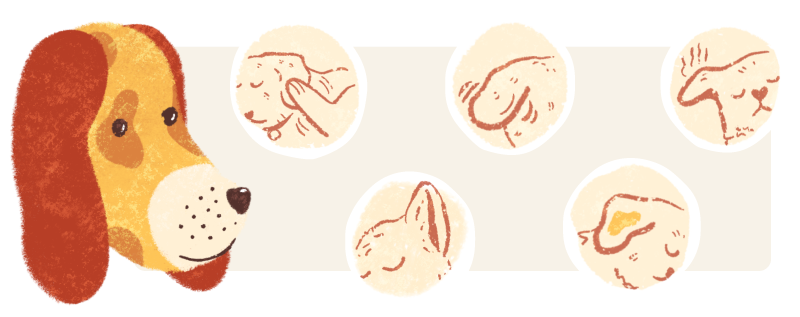Understanding and Healing Ear Infections in Dogs

By Dr Edward Bassingthwaighte

Ear infections are a reasonably common problem in dogs. Today I’ll share with you how to pick up the early signs in your dog, how to prevent ear infections, and my approach for treating them as holistically as possible.
But before we get stuck into that, let’s explore some predispositions. Most ear infections occur in dogs that have heat and inflammation (allergies), or anatomy that reduces ventilation of the ear canal. Reduced ventilation means increased humidity. Increased inflammation leads to a warmer environment. Bacteria and fungi both love heat and humidity!
The number one predisposition is large, floppy ears. Breeds like the bloodhound are an extreme example of this, but any breed with floppy ears hanging down over the ear canal is more likely to suffer from ear infections. Floppy ears trap heat and moisture in the ear canals.
Number two is extremely hairy ears, with a lot of hair inside the ear canal. The hair once again reduces air circulation and increases dampness. It also traps wax down in the ear canals. Poodles, Bichon Frise, Lahsa Apso, Shi Tzu, and Lagotto (and their crosses - so all ‘Oodles’) are breeds that tend to have this problem.
Number three is narrow ear canals. Some breeds have a narrow channel, which causes the same issues of reduced ventilation, and increased humidity. Shar Pei, Bulldogs and Chow Chows tend to have narrow ear canals.
Number four is allergies. Allergies increase inflammation, which increases heat and moisture in the dog's ears. That provides the perfect environment for yeast and bacteria to grow. In my experience, a lot of ear infections - especially chronic ones, are secondary to allergic issues.
The dogs least likely to have ear infections are prick-eared dogs- dogs with ears that stand up and are open, without much hair in the ear canals. They can still have ear infections, of course, but it is less common.

Ear infections in dogs - how they happen
Ear infections happen when there is growth of bacteria and or fungi (yeast) in the ear canal. Once these pathogens get growing, your dog’s immune response kicks in, causing inflammation, and exudates of inflammatory cells. You can get a primary ear infection without any predispositions - especially if you have dogs who love the water and swimming.
With any ear infection, you will see some or all of the following signs.
- Reddening and inflammation of the ear canal (and sometimes the ear flaps)
- Smelly ears
- Head shaking, scratching at the ears
- Discharge - can range from brown and sticky through to pussy and foul
- Off colour, unhappy
- Thickened skin (including ear canals)
- Swelling, pain, itchiness
- Scabs or crusting in the ears
Remember, if you have a dog with allergies, the chances of ear infection are a lot higher, so you’ll need to check them regularly. Especially if there is a flare-up with scratching, chewing at paws, etc.
How to check your dog for ear infections
It’s pretty simple. Once a week, have a good close look at and inside your dog’s ear. And get your nose nice and close and give them a good sniff. Any level of unusual or bad smell is a big red flag. Yeast infections smell like corn chips. Bacterial infections smell yucky.
So then what do you do? If there is an active ear infection, please don't try to treat your dogs at home. It turns out a very popular Google search term is ‘How to treat dog ear infections without vet’. Not seeing a vet is a bad idea, as most times your dog will need prescription antifungal/antibacterial ear drops.

Your vet will need to take a swab and look at it under the microscope. Then they will be able to see if there are yeast, gram +ve bacteria, gram -ve bacteria, or some combination of these. Each different type needs different treatment. You’ll need to apply ear drops for 10 days, then go back for a recheck.
Don't skip your recheck!!! If there is still an infection, your dog will likely need a general anaesthetic so the vet can thoroughly flush the ear out, getting rid of any debris that might stop the treatment from getting in and being effective.
Once the ear infection is gone, (or before it gets started, preferably) then you can use the best treatment of all - PREVENTION. Here’s my approach for a holistic prevention strategy.
- Deal with all predispositions. You can’t change the shape of ears, but you might be able to prevent swimming or wrap your dog’s head in glad wrap to keep ears dry. If your dog has allergies, make sure you are NOT feeding any kibble or carbs, and get your dog onto a fresh whole foods or BARF diet like Big Dog. And with all allergic dogs, get stuck into creating a holistic health plan to deal with that problem at the root cause.
- Use a weekly ear wash. There are heaps of commercial options, but I like a 10% solution of raw apple cider vinegar in spring water.
- Check your dog's ears carefully every week. And take your dog to the vet at the first signs of any problem. Chronic ear infections cause scarring and narrowing of the ear canals over time, which then makes the whole problem worse and worse.
Severe chronic ear infections can be really challenging to treat, and in some cases a total lateral ear canal ablation will be necessary. This is a surgery where they open up the ear canal to the outside, allowing plenty of air and ventilation. That should definitely be a last resort. It’s a daily major surgery, but it can be a literal lifesaver!

If you want to take the most natural, holistic route, focus on selecting a puppy/breed without predispositions, minimise vaccination (over-vaccination and vaccination injury often trigger allergies), be very proactive in treating all allergy issues, feed a high-quality fresh whole foods/BARF diet, and check your dog’s ears weekly.
If you catch the very early signs, sometimes a simple ear wash will do the
trick, but if you try that and the ears are not totally normal within 48 hours (dry, no redness, no smell, no discharge, no itching or ear flapping), you must go to your vet. The only way to give the appropriate treatment is by swabbing the ear and seeing what is there under the microscope.
And I’ll repeat this because it’s really important. DON’T MISS YOUR 10-DAY RECHECK! Often it’ll seem quite a bit better, but on the swab I’ll find bacteria and yeast still active, and need to either try a different treatment, or escalate to a GA with a total flush and packing the ears with antibiotic/antifungal ointment. It’s one of those problems (sadly) where you really do need prescription medications to deal with an active infection nearly all of the time.
If you have a dog who is hard to treat and get drops into, you may need to ask your vet for the longer-term ointment to be administered in hospital. That lasts for 10 days (in a greasy lanolin base). Some dogs get a real phobia about treating their ears.
That will help you know what to do. If you’d like a consult with me, please pop into www.thehealingvet.com - love to help you help your pets!
About the Author - Dr Edward Bassingthwaighte.

Dr Edward Bassingthwaighte is a holistic veterinarian, and a world-leading expert in silent pain in pets. Dr Edward is passionate about fresh raw whole foods for dogs. He is the founder of the Whole Energy Body Balance method- a profoundly healing bodywork modality for pet parents and pet wellness professionals to relieve silent pain, anxiety and trauma in pets. Join Dr Edward's free masterclass on silent pain in pets here.
If you liked this article, sign up to our Big Dog Fam Mail to receive more great pet health and happiness advice.
